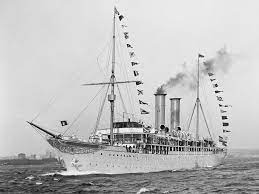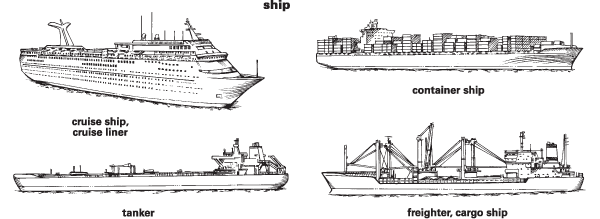The History of the World's First Cruise Ship Built Solely for Luxurious Travel

At the turn of the twentieth hundred years, a German Jewish transportation chief had a creative thought for another income stream...
the journey Shipping head honcho Albert Ballin had a dream. He saw a fate of relaxed ocean go accessible to anybody ready to follow through on the cost of a ticket. The late-nineteenth century head of the Hamburg-Amerikanische Packetfahrt-Actien-Gesellschaft (HAPAG), or Hamburg-America Line, knew the eventual fate of the organization rested past delivery freight across the Atlantic.
The Jewish child of a Danish outsider assumed control over his dad's movement organization in 1874. In any case, he turned out to be important for Germany's first class (an odd fit since destructive perspectives towards Jews were at that point coming to fruition) when he changed the privately-owned company into a free delivery line, procuring the consideration of HAPAG chiefs who recruited him in 1886 and made him their overall chief in 1899.
One of his most memorable things to address subsequent to accepting the influential position was to commission the main reason fabricated voyage transport the world had at any point known: the Prinzessin Victoria Luise.
"The Hamburg-America Line was the world's biggest delivery firm at that point," says Peter McCracken, a custodian at Cornell University and distributer of the vessel-research data set ShipIndex.org. "As its overall chief, Ballin was liable for keeping up with that position and for pushing the organization ahead."
Over the earlier 10 years, Ballin directed the development of the traveler arm of the organization by retrofitting cargo ships into scarcely adequate luxury ships to some achievement. However some HAPAG chiefs at first dismissed the thought ("Germans will go due to legitimate need, yet they would doubtlessly not submit themselves to the dangers and distresses of a long journey only for its coincidental fun," one partner told him,) Ballin continued at any rate.
He started in January 1891 by reusing the Augusta Victoria, one of the sea liners in the organization's armada, into a comfortable cruising vessel for well off sightseers. Likewise, he realized he expected to counterbalance misfortunes throughout the cold weather months, when less cargo orders came through and frozen streams made ocean travel perilous. Daniel Finamore, partner head of displays at the Peabody Essex Museum in Salem, Massachusetts, says that Ballin comprehended the organization required "to augment utilization of their huge boats" by "sorting out delight travels to Caribbean ports and hotter environments during winter."
Ballin before long understood, notwithstanding, that the Augusta Victoria had huge restrictions when it came to delight avoidances adrift. Travelers needed to endure unattractive hardware, prohibitive deck space, and an absence of installed conveniences. The actual boat was too enormous to even think about exploring into the more modest ports close to well known traveler objections. What's more, the stark dozing facilities were bothersome for decent top of the line travelers all of which made the Augusta Victoria a brief measure. Logical American revealed at the time that "the endeavor was looked upon...as an all around try."
1901 "Logical American" cover showing the inside and outside of the boat
1901 Scientific American cover showing the boat's inside and outside Public area by means of Wikimedia Commons
His advancement was perceiving the allure of extravagance ocean travel planned explicitly for the experience of the excursion.
By 1899, Ballin employed the shipbuilder Blohm and Voss to build a vessel explicitly equipped for what he had at the top of the priority list. In the Prinzessin Victoria Luise, he had a 407-foot, 4,419-ton vessel with twin-screw motors that could slice through the water at a speed of 16 bunches. (Around 19 miles each hour; the Titantic's maximum velocity was 23 bunches.) In 1971's The Sway of the Grand Saloon: A Social History of the North Atlantic, creator and antiquarian John Malcolm Brinnin portrayed the boat as having "the white structure of a yacht, a long trimmer stem and bowsprit, buff-shaded pipes."
In February 1901, Scientific American featured that the vessel was "intended for a class of administration which up until recently has been performed by the ordinary boats of this company...the first vessel of her sort to be constructed only for yachting [leisure cruising] purposes."
Brinnin gives Ballin full credit for the achievement: "The genuine forward leap in joy cruising, as the twentieth century would come to know it, was...the courageous token of Albert Ballin," he wrote in Grand Saloon.
Without a doubt, James Delgado, the previous overseer of NOAA's Maritime Heritage Program, and senior VP of SEARCH, a marine prehistoric studies program, recognized Ballin's commitments too and says there is agreement that the Prinzessin Victoria Luise was the "main reason fabricated, non-private journey transport: what we call 'voyage' delivers today."
Named by Ballin after the German ruler's just little girl, the Victoria Luise flaunted a huge recreation center, a social lobby, a library, a smoking room, a palatial craftsmanship exhibition encompassing the lounge area, extensive promenade decks, an assembly hall for moving, a darkroom for beginner photographic artists and 120 strangely large five star just staterooms — each outfitted with exquisite European goods, metal beds and twofold light windows that were opened when the boat was in warm environments. "It was Ballin's goal that the style and administration (on board) ought to be proportionate with the best European lodgings," says Bruce Peter, a plan student of history at the Glasgow School of Art in Scotland and creator of Cruise Ships: A Design Voyage.
"There was no thought for obliging lesser admission travelers or cargo," Delgado makes sense of, "simply cruising in style in all around delegated lodges with great food and visiting various ports."
Subsequent to sending off from Hamburg on June 29, 1900, the Victoria Luise's most memorable voyage endured 35 days and investigated ports in the West Indies and Venezuela. Resulting Victoria Luise travels now and again followed similar course, on occasion changing objections across the Mediterranean and Baltic Seas and then some. "The vessel cruised to Norway and the Baltic in summer, to the Mediterranean and to the Caribbean in winter," Peter says, noticing "the four ever-well known cruising districts." Over the years it docked in ports in New York, France, England, Ireland, Scotland, the North Cape in Norway and St Petersburg.
"Each port had very much arranged shore journeys," says Finamore.
Despite the fact that the superrich as of now had yachts of their own "none were accessible for public appointments," Finamore makes sense of — and Ballin realized he'd have to market to a well off customer base to make the endeavor a triumph. Keeping that in mind, he mentioned that designing diaries allude to the Victoria Luise as a "cruising yacht."
The Victoria Luise made relaxation cruising accessible to individuals who couldn't manage "the upkeep and support, not to mention the cost of building such vessels," Delgado says. Adds Peter, "There was a powerful urge among the exceptionally well off to imitate the style of royals and heads." Its ubiquity made the ways for some extra such vessels being dispatched by HAPAG authorities; with other famous delivery lines of the day sticking to this same pattern. (Counting the White Star Line, the route organization answerable for dispatching the Titanic.)
The deck of the Victoria Luise flaunted an extremely durable canopy structure that gave shade and sanctuary while neighboring performers engaged visitors. Inside, "a string group of four would play from the feasting cantina overhang at supper," Peter says, and "nearby entertainers would be brought locally available to provide the travelers with a sample of the fascinating when in unambiguous ports."
Notwithstanding diversion, travelers anticipated debauched food ready and appreciated it in overflow, however not without extraordinary exertion. "Top notch food on a boat, for example, this was a specific test," Finamore says. "All that on an expansive menu offering numerous courses must be arranged, put away, safeguarded and ready." Menu choices on board one Victoria Luise voyage included hamburger stock with farina dumplings and dish duck and whortleberry soup. To observe Abraham Lincoln's birthday adrift on February 12, 1906 — either as a sign of approval for the boat's American travelers or simply a reason to set up a party, or both — the culinary specialist offered choices of broiled halibut in Russian sauce, or Strasbourg goose in jam, while the boat's band played John Philip Sousa's "The Stars and Stripes Forever" from the encompassing overhang.
While on a Caribbean journey in December 1906, the boat ran into an unfamiliar edge off the bank of Jamaica. Public area through Wikimedia Commons
High end food and energetic diversion were not a viable replacement for good seamanship, in any case, and the magnificence and quietness of the Prinzessin Victoria Luise was brief. While on a Caribbean voyage in December 1906, it ran into an unknown edge off the shore of Jamaica. Skipper H. Brunswig had attempted to enter the harbor without help and had mistakenly distinguished the Plumb Point Lighthouse for the beacon at the port he was expected at, the Port Royal Lighthouse. To exacerbate the situation, Peter says, "the state of the seabed off Jamaica had been changed by a new volcanic ejection, so the graphs the chief relied upon were off-base."

However no travelers were hurt when the boat steered into the rocks (everybody was saved by the next morning), Brunswig withdrew to his lodge after the clearing and took his existence with a gun. "I can't represent his demonstration besides on the hypothesis that his pride was squashed by the mishap, and that he accepted that main passing would clear out what he viewed as his shame," a HAPAG leader said at that point. A New York Times article of a couple of days after the fact said the skipper had been "one of the most mind-blowing known and most.


0 Comments